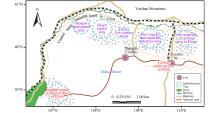Sciences in Cold and Arid Regions ›› 2018, Vol. 10 ›› Issue (4): 286–292.doi: 10.3724/SP.J.1226.2018.00286
Industrialization model of enterprises participating in ecological management and suggestions: A case study of the Hobq Model in Inner Mongolia
Yong Chen1,Tao Wang1,*( ),LiHua Zhou1,2,Rui Wang3
),LiHua Zhou1,2,Rui Wang3
- 1 Key Laboratory of Desert and Desertification, Northwest Institute of Eco-Environment and Resources, Chinese Academy of Sciences, Lanzhou, Gansu 730000, China
2 Institutes of Science and Development, Chinese Academy of Sciences, Beijing 100190, China
3 College of Land and Resources, China West Normal University, Nanchong, Sichuan 637002, China
| 1 |
Brennan S, Ackers S Recycling, best value and social enterprise: assessing the 'Liverpool Model'. Local Economy 2004; 19: 2 175- 180.
doi: 10.1080/0269094042000208266 |
| 2 | Chen H Ecological enterprise and the establishment of enterprise ecological mechanism. Management World 2003; 2 99- 104. |
| 3 | Chen W, Peng JC, Wu Q Spatial and temporal differences in industrial land use efficiency in China. Resources Science 2014; 36: 10 2046- 2056. |
| 4 |
Chen Y, Tong ZF, Pu YJ The construction and application of the evaluation index system about the circular economy development level of iron and steel enterprises. China Soft Science 2009; 12 102- 110.
doi: 10.3969/j.issn.1002-9753.2009.12.013 |
| 5 |
Gibbs D, Deutz P Reflections on implementing industrial ecology through eco-industrial park development. Journal of Cleaner Production 2007; 15: 17 1683- 1695.
doi: 10.1016/j.jclepro.2007.02.003 |
| 6 | Jing S The analysis of enterprise social responsibility of ecological era. Ecological Economy 2008; 5 91- 93. |
| 7 |
Liu N, Zhou LH, Chen Y, et al. Identification and evaluation of desertification reversal in China: indicators and methods review. Sciences in Cold and Arid Regions 2014; 6: 3 190- 200.
doi: 10.3724/SP.J.1226.2014.00190 |
| 8 |
Lu DD, Liu Y, Fan J The regional policy effects and regional development states in China. Acta Geographica Sinica 1999; 54: 6 496- 508.
doi: 10.3321/j.issn:0375-5444.1999.06.003 |
| 9 | Naughton BJ, 2006. The Chinese Economy: Transitions and Growth. Cambridge: MIT Press, pp. 55–56 |
| 10 |
Sekerka LE, Stimel D How durable is sustainable enterprise? Ecological sustainability meets the reality of tough economic times. Business Horizons 2011; 54: 2 115- 124.
doi: 10.1016/j.bushor.2010.09.006 |
| 11 |
Spengler T, Püchert H, Penkuhn T, et al. Environmental integrated production and recycling management. European Journal of Operational Research 1997; 97: 2 308- 326.
doi: 10.1016/S0377-2217(96)00200-7 |
| 12 |
Umble EJ, Haft RR, Umble MM Enterprise resource planning: implementation procedures and critical success factors. European Journal of Operational Research 2003; 146: 2 241- 257.
doi: 10.1016/S0377-2217(02)00547-7 |
| No related articles found! |


